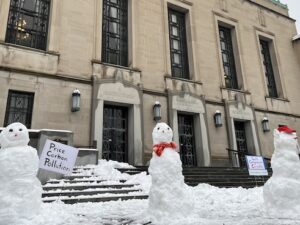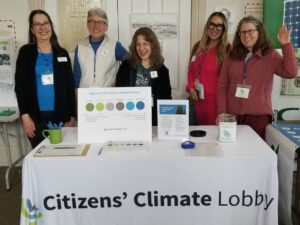
These beautiful hay bales are a sight missing from many Montana farms this summer, due to the harsh drought conditions.
By Alex Amonette
This summer, Montana suffered an extreme “flash” drought and intense forest and plains wildfires. The governor declared a drought emergency in July 2017. It has been devastating for Eastern Montana ranchers.
One of those ranchers is Todd. He and his family ranch and farm in Eastern Montana. They have about 300 acres of irrigated land and about 3400 acres of pasture land. They raise corn for silage and alfalfa for hay. They also raise forage-variety grains, such as barley, sorghum, millet, or winter wheat. They only raise forage crops for their cattle. Presently, they don’t sell any cash crops. I spoke with Todd to learn some of what they went through this summer.
“This summer was relentlessly stressful. We normally receive 12-15 inches [of rain] per year. Before the rains in mid-September, we had only received 1.5 inches for the 2017 crop season,” he said.
To keep the farm going in such harsh conditions this summer, Todd’s family had to put in a lot of extra time. “My family and I do all the work, and we’ve been pulling 16-hour days since May. We don’t get time off,” he said. “We work every day, all day. We work weekends, we skipped 4th of July parties, birthdays, and other get-togethers with friends, and we never took a vacation. As soon as I got off work at my day job, I’d drive out to the ranch, work until 10 p.m., eat a microwaved meal, and head to bed to press ‘repeat’ at 6 a.m. the next morning.”
The conditions that were tough on the crops and animals were also physically tough on Todd and his family. “The high temperatures caused heat exhaustion, and the constant 20+ mph winds wore us down. We’re also terrified that fire will rampage through our ranch and burn our livelihood to ash and smoke.”
Lighter cattle
The lack of rain meant that pastures weren’t growing enough to support the entire herd, so half their herd went into feedlots. That created other problems.
“Our feedlot calves are about 200 pounds lighter than calves that spent the summer on pasture,” Todd explained. “Every day, we had to provide feed for over 250 head. We normally don’t feed cattle from about June until October, but this year, we never stopped feeding them. We’ll spend more money on feed than usual to get those calves up to sale weight.”
Saved by the irrigation system
In the past, Todd’s farm relied on flood irrigation, but last year, they installed a brand new irrigation system. The system cost $400K and included 2 pivots, 7500 feet of pipelines, $50K worth of electrical service lines, and a new electrical pump Todd and his dad engineered and built. That system saved them this year.
Todd said, “The system was so capable and reliable that we basically had complete control over when and how much ‘rainfall’ we needed. We actually recorded our highest yields to date. Non-irrigated alfalfa was so stressed that it only grew to 2 inches in height. Irrigated alfalfa a couple feet away grew to waist-height, for three cuttings. We consider ourselves immensely lucky. If we hadn’t installed that system last year, we would have very little feed for our cattle now.”
He added, “With the drought came waves of temperatures more than 100°F, which meant that the corn received above average heat units. Corn prefers hot temperatures, if it has plenty of water available in the soil. Since we could provide the necessary irrigation, our corn performed very well, and finished early. I repeat—my family feels very lucky to have the new irrigation system. It cost us over $400,000, but it proved invaluable this year.”
Though they’re enjoying the success of their irrigated crops, they’re still paying the price for all that irrigation. “I have yet to see the bill for this month, but we’ll pay over $20K in electrical bills to irrigate our crops this year,” he said.
“For farmers without irrigation, they can’t escape their dying crops,” he added. “Every day they wake up to wheat that never sprouted from the ground, or corn that’s dried up and blowing away in the hot winds. It requires a special fortitude to pick ourselves up from the stress. Every day is stressful.”
Looking ahead to next season
The family is concerned they won’t have enough feed for the winter. They were unable to buy enough straw bales from neighbors, whose crop failed, and their normal purchased feed supplies have diminished greatly.
Todd said, “If we don’t pull out of the drought by next spring, my family and other ranchers will be in serious trouble because we’ve grazed all our available pasture. Dryland farmers are, of course, worried, because their soil no longer has any moisture reserves for next year’s crops. Many of us are doomed if we don’t get rain.”
Todd shared that grain and livestock commodity prices are “painfully low,” and that adding drought to the mix has made ranching families tighten their belts. Small town economies depend on the agricultural community for business. If no one has the means to buy new clothes, go out to eat, buy new equipment, or even go to a movie, those towns’ businesses suffer.
Understanding the causes
Do farmers and ranchers think the climate is changing or that it is human caused? Some do, some don’t. They work extremely hard, don’t have time to “research the intricacies and science behind climate change,” Todd said. He added that many just “submit to the political consensus shared among our friends/family, who are typically conservatives.”
But he appreciates the interest we in Citizens’ Climate Lobby are showing in the agriculture community because, he said, “We’re typically ignored by lobbyists and the media.”
He concluded by saying, “I really should side with scientists on climate change; however, the movement is so politically charged that I instead get skeptical. I promise I’m not just another close-minded oil supporter.” Fortunately, the bipartisan Climate Solutions Caucus in the U.S. House of Representatives is working hard to overcome this partisan divide and provide solutions to mitigate our changing climate.
Plus, resources specific to Montana offer compelling data. The just-released Montana Climate Assessment reports: “Since 1950, average statewide temperatures have increased by 0.5 °F/decade (0.3°C/decade), with greatest warming in spring; projected to increase by 3-7°F (1.7-3.9°C) by mid-century; global atmospheric carbon dioxide concentrations have increased over 100 ppm since Montana statehood [1889]; increased variability in precipitation suggests potential for more severe droughts, particularly in connection with climate oscillations.”
The earth’s climate has changed numerous times. Montana was once covered in ice and at other times, was a sea! These changes in climate took a very long time. This time, it’s different. The change is speeded up. Since the industrial revolution, human activities like the burning of fossil fuels and deforestation have released heat-trapping “greenhouse gases” (carbon dioxide, methane, and others) into our atmosphere. Too many of these gases block the heat from the sun as it tries to escape the earth’s atmosphere, warming it too much, raising our temperature, melting our glaciers, raising the sea levels and changing our climate. Evangelical Christian and scientist Dr. Katharine Hayhoe describes it well here.
Let’s keep on talking
I appreciate Todd’s willingness to share his family’s experience with this summer’s drought in Eastern Montana. We’ll keep our conversation going and learn from each other. Certainly, CCL and the ag community can work together to mitigate and adapt to our changing climate, before we are unable to do so. I think the best first-step economic solution is the Carbon Fee and Dividend. I look forward to discussing that sometime soon with Todd.





